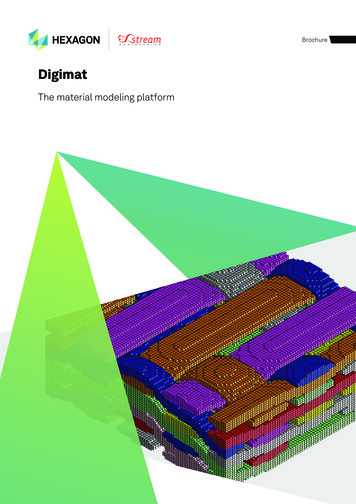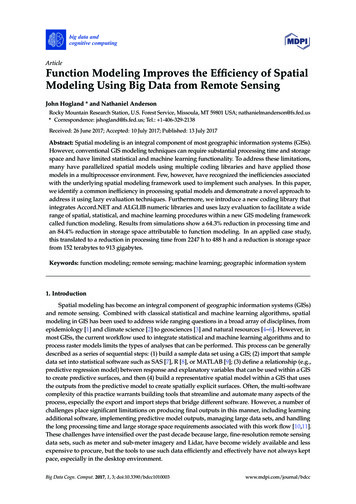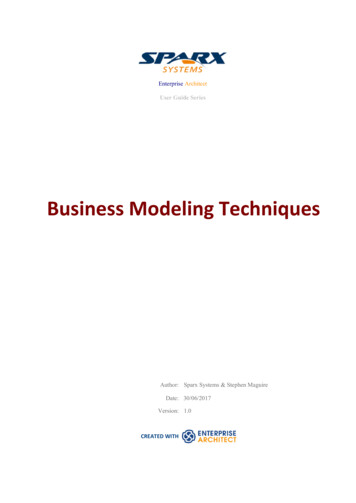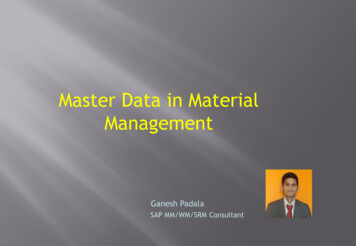
Transcription
BrochureDigimatThe material modeling platform
DigimatThe material modeling platforme-Xstream engineering develops Digimat, a state-of-the-art multi-scale material modeling technology thathelps speed up the development processes for plastic,composite and other heterogeneous materials andstructures. Digimat is used by CAE engineers, specialists in manufacturing processes of composite materials,and materials scientists to accurately predict the nonlinear behavior of complex multi-phase compositematerials and structures. Digimat, the award-winning software, is relied upon by major Material Suppliers,Tier1s and OEMS worldwide in various industries. It bridges the gap between manufacturing and structuralperformance. It helps multi-industries using plastics & composites.e-Xstream’s team help engineers, managers and corporations optimize and improve their engineering processes bydeveloping, implementing and customizing tools and solutions as well as consulting on critical projects:ToolsA complete set of complementary interoperable software products focused on expert usage for material and/orstructural engineering.SolutionsDigimat’s applications follow three major strategies:Material Engineering and Virtual TestingThe purpose of material engineering is to take a simulation approach for the identification of promisingcandidates for new composite materials thereby reducing the amount of experiments needed. This helps tosave money and to reduce the time needed to develop new materials.In research the approach allows to gain insight into and to understand mechanisms that dominate themacroscopic material properties but actually arise from its microscopic composition.Process SimulationEasy, process-centric, and user-friendly usage of Digimat technology from a fully integrated GUI guided environmentsfor specific tasks (e.g. running coupled analyses for short fiber reinforced plastic parts with Digimat-RP).eXpertiseKnowledge transfer from 15 years of experience in micromechanical modeling. It includes a Digimat Users’ andExample Manual, as well as access to e-Xstream offers for services, support and trainings. Digimat, furthermore, offersonline social platforms to share insights and get updated on recent activities and news.Award-winning e-Xstream engineeringDigimat provides process simulation solutions for the additive manufacturing of polymers. It helps processengineers to anticipate manufacturing issues and optimize part quality (ex: minimize warpage and residualstresses) by predicting the relative influence of the various process parameters. Digimat also has capabilitiesallowing to predict curing kinetic and its influence over the material and structural behavior of thermosetcomposite parts.Structural EngineeringThe purpose of structural engineering is to design full composite parts. The focus is on the part performanceas it depends on the material characteristics and the manufacturing method and conditions that were usedfor the individual design.Key to this challenge is a material model that correlates to experimental behavior as closely as possible. Forthis purpose a reverse engineering procedure is used that results in the parametrization of micro-mechanicalmodels and their adaption to a set of anisotropic material measurements to meet the global compositeperformance best possible.Such material models can now read locally different micro-structure information from various sourcesand convert them into a local material property. A fully coupled analysis results in a simulation model withindividual material properties described for each integration point in the Finite Element analysis. Coupledanalyses are state-of-the art for the modeling of composite parts and have proven to match experimentalobservation perfectly on many occasions.2Manufacturing Intelligence hexagonmi.com e-xstream.come-xstream.com hexagonmi.com Manufacturing Intelligence3
Digimat-MFFailure IndicatorsFatigue Pseudo-grain based fatigue model specificallyfor short fiber reinforced plastics Matrix damage based fatigue model forunidirectional composites Pseudo-grain based fatiguemodel specifically Digimat-MF is a mean-field homogenization tool used to rapidly compute the macroscopic performance ofcomposite materials based on their per-phase properties and microstructure definition. Digimat-MF aimsat realistically predicting the nonlinear constitutive behavior of multi-phase materials taking into accounttemperature and strain rate dependencies. The composite morphology such as filler content, length,aspect ratio and orientation take full impact on the resulting composite behavior.Applied at micro and/or macro scale, or on pseudo-grainsusing the FPGF model (First Pseudo-Grain Failure model),including multilayer failure controls Failure models: Maximum stress and strain, Tsai-Hill 2D, 3D &3D Transversely Isotropic, Azzi- Tsai-Hill 2D, Tsai-Wu 2D, 3D &3D Transversely Isotropic, Hashin-Rotem 2D, Hashin 2D & 3D,SIFT, Christensen, User-definedThe technology is especially well suited for describing fiber reinforced composites: Strain rate dependent failure criteria Failure criteria on Leonov-EGP & hyperelastic materialmodelsLoading Short fiber reinforced plastics Long fiber thermoplasticsProgressive Failure Unidirectional composites Woven compositesFailure: Hashin 2D / Hashin 3D / Hashin-Rotem 2D/Multicomponent 2D Damage: Matzenmiller / Lubliner / Taylor (MLT) / Individualdamage evolution functions Stabilization control using viscous regularizationA broad range of performances can realistically be predicted: Monotonic, cyclic or user-defined history loading Multi-axial stress or strain, General 2D & 3D, Harmonic Mechanical and thermo-mechanical Prediction of thermal & electrical conductivitiesFurther functionalities: Prediction of orthotropic engineering constants Stiffness User defined outputs Failure Interoperability with Digimat-FE and Digimat-MX Creep Handling of encrypted material files Fatigue Conductivity (thermal & electrical)Nonlinear (per-phase) Material ModelsMicrostructure Morphology Linear (Thermo) Elasticity: Isotropic /Transversely isotropic / Orthotropic / Anisotropic Multiple reinforcement phases Linear (Thermo)Viscoelasticity Multi-layer microstructure (Thermo) Elastoplasticity: J2 Plasticity andIsotropic hardening (Power / Exponential /Exponential laws) or Kinematic hardening (linearwith restoration) for cyclic elastoplasticity. Ellipsoidal reinforcements (fillers, fibers,platelets) Aspect ratio distribution General orientation (fixed, random, 2nd orderorientation tensor) Pressure dependent elastoplasticity : DruckerPrager Void inclusions Temperature and strain-rate dependentelastoplastic models. Coated inclusions with relative or absolutethickness Elastoplasticity with Damage: LemaîtreChaboche Deformable, quasi-rigid or rigid inclusions (Thermo) Elasto-Viscoplasticity: ClusteringNorton / Power / Prandtl laws Viscoelasticity-ViscoplasticityHomogenization Methods Hyperelasticity (finite strain): Mori-TanakaNeo-Hookean / Mooney-Rivlin / Ogden /Swanson / Storakers (compressible foams) Interpolative double inclusion 1st and 2nd order homogenization schemes Multi-step, multi-level homogenization methods Elasto-viscoplasticity (finite strain): Leonov-EGP Thermal & electrical conductivity: Ohm & FourierStiffness & failure of thermoplastics based woven composites dependent of the fiber orientatione-xstream.com hexagonmi.com Manufacturing Intelligence5
Digimat-FEDigimat-FE is the tool performing computational homogenization, starting at microscopic scale in orderto gain an in-depth view into the composite material by the direct investigation of Representative VolumeElements (RVEs). Digimat-FE can act as a stochastic generator of highly realistic RVEs covering a largevariety of materials: plastics, rubbers, metals, ceramics, nano-filled materials. It also allows importingmicrostructure from geometry files (e.g. STL files) or 3D image files (e.g. RAW file), or to manually import singleinclusion geometry and position them within the RVE.Microstructure Definition Predefined phase types: matrix, inclusion, continuousfiber, void, yarn, strand, grain Microstructure morphology definition: Volume /Massfraction Multiple inclusion shapes General orientation definition (fixed, random, 2ndorder orientation tensor, from EBSD/ODF data forpolycrystalline materials) Fiber length or grain size with access to sizedistribution Coating Finite element solver with CPU based parallelization. Inclusion / Matrix debonding Spectral solver with CPU & GPU based parallelization. Multi-layer microstructureA complete end-to-end solution has been implemented in Digimat. It allows performing all the different stepsneeded to obtain a complete FE analysis - starting from the material data. For instance, the steps followed tomodel woven composites are: Predefined microstructures: generic, fabrics, lattices,foams, polycrystalline metals, cemented metals. Imported from STL geometry or 3D RAW image files. Extraction of the material data from the datasheetRVE Generation Mean-field homogenization of the yarns Generation of a geometry of a unit cell Generation of a RVE Voxelisation Based on material input and the microstructure definition, a finite element model is built and submitted toanalysis. The results of the FE analysis are post-processed by using probabilistic distribution functions thatgive detailed insight into the RVE. Mean homogenized values are computed and can be used in subsequent FEanalysis on the structural part level.Digimat-FE allows to solve the problem at-hand over the RVE using internal Finite Element of FFT/spectralsolvers, or to export corresponding finite element models.End-to-end solution RVE microstructure generation with real-time preview& animation process Random positioning, maximum packing or randomperturbation algorithmsFE model definition and application of periodic boundary conditions 3D & 2D RVEs Solving the FE analysis Unit cell generation. Post-processing the outputs of the FE analysisLatest Capabilities New microstructures Foams: open and closed cells (random or periodic Polycrystalline materials Lattices Imported from STL geometry or RAW images filesEmbedded solver Digimat-FE solvers for end-to-end solutionFE analysis can be started & monitored from within DigimatFEPost-Processing Field visualization of results over RVE Computation & visualization of resultant distributions overRVE Computation of representative (mean) propertiesFE Meshing User defined failure indicator Custom weave pattern for woven 3D Voxel and conforming internal mesher available for FE/Solver Grid generation for FFT/Spectral solver Export finite element models to : Marc, Abaqus/Standard, Ansys and LS-Dyna. RVE meshing embedded beam elements,straight or curvedRVE AnalysisMain Capabilities Monotonic / Cyclic / User-defined history loadings Definition of composite constituents Multi-axial stress or strain, General 2D & 3D Inclusion shapes (Spheroid, Platelet, Ellipsoid, Cylinder,Curvy fibers, User defined, etc.) Mechanical and thermo-mechanical Computation of the percolation threshold Material models (Elastic, (Thermo) Elastic, (Thermo)Elastoplastic, Viscoelastic, etc.) Prediction of thermal and electrical conductivities Inter-operability with Digimat-MF and Digimat-MX Loading definition from structural FEA, i.e. AbaqusODB file, Marc t16 file Export of RVE geometry in common formats: STEP,IGES, BREPVoxel based solution for a woven 2.5D composite materialcomputed in Digimat-FEGeneration of complex RVE based on geometric shape & size distributione-xstream.com hexagonmi.com Manufacturing Intelligence7
Digimat-MXParametric identification Digimat-MX is an eXchange tool that allows the user to reverse engineer, store, retrieve and securely sharemicromechanical models between material experts and designers of composite parts.Digimat-MX tool stores anisotropic measurements and related micromechanical models. Embeddedparameterization tools allow you to adapt the material performance to experimental data. Resulting Digimatmodelscan be shared within large communities of different users. Intellectual property is assured by built-inencryption technology.Digimat-MX comes along with:Public DataReady-to-run Digimat material models Experimental data as a base for building Digimat material models Database setup & tools: Data import & reverse engineering of Digimat material models Encryption technology for secured sharing Automatic reverse-engineering of material modelparameters for SFRP from data-sheet informationFrom e-Xstream: generic grade (chopped fiberand continuous fiber) Given access to:Validation of calibrated material model parameters usingfinite elements models of dumbbells Support of failure multilayer trigger Support of any loading angle Stress localization factor computation Public Database new content: Asahi Kasei, Borealis, DSM,Dupont, Kuraray, Sabic, Domo, Solvay Specialty Polymers,Stratasys Inc., Sumika Polymer Compounds, Evonik, Avient,Radici, PolyOne, Ascend, Kolon plastics, Toray, MarkForged,Hankuk Carbon, Mitsui Chemicals & LG chemicals. Experimental data (tensile)Digimat material / analysis files forhomogeneous / composite materials:chopped fibers (short, long), continuousfibers (woven, unidirectional)Data available under various conditions: Temperature, relative humidity, strain rates& loading angles Import, Filter & Reverse Engineering toolsMain CapabilitiesMaterial database Public data: 8From material suppliers: AGATE, Asahi Kasei,Borealis, Dupont, DSM, EMS-GRIVORY, EVONIK,Kuraray, LyonDellBasell, NCAMP, Radici, SABIC,Domo Engineering Plastics, Solvay SP, Stratasys Inc,Sumitomo, Sumika Polymer Compounds Celanese,Trinseo, Victrex, Avient, PolyOne, Ascend, Kolonplastics, Toray, MarkForged, Hankuk Carbon, MitsuiChemicals & LG chemicals.Manufacturing Intelligence hexagonmi.com e-xstream.com- Linear elasticity, PFA- Requires basic datasheet information Interactive reverse engineering Various loading angles, strain rates and / or temperatures At homogeneous and macroscopic level Material models that can be reverse engineered: Material files can be encrypted for confidentiality purposes(available in MX ) Encrypted files can be used in Digimat-MF, Digimat-RP,Digimat-AM and Digimat-CAE, the material parameters beinghidden- ViscoelasticEncrypted material files can be attributed anexpiration date (available in MX )- (Thermo) Elasto-viscoplastic- (Thermo) Elastic- (Thermo) Elastoplastic- Viscoelastic-viscoplastic Data sheet generation of Digimat material models, as well asof experimental files, in pdf format. Database summaryFailure indicators that can be reverse engineered:- Maximum stress, maximum strain- Tsai-Hill 2D, Tsai-Hill 2D in strain- Tsai-Wu 2D, Tsai-Wu 2D in strain- Hashin Rotem 2D- Tsai-Hill 3D transversely isotropicReverse EngineeringNew filtering experienceEnhanced SFRP fatigue reverse engineeringAvailable for CFRP (glass and carbon fiber- Hashin 2D Latest Capabilities Encryption Additional Digimat-MX toolsFlexible user/group scenarios - Can be done on one or several curves at the same time Identify material model parameters based on thehomogeneous material responses- Requires at least 2 stress-strain curvesPublic data for Short fiber reinforced plastics and UD &woven compositesTwo methods are available: automatic for easy and efficientreverse engineering, and interactive for expert reverseengineering.- Tsai-Wu 3D transversely isotropic- SFRP pseudo-grain fatigue Other features that can be reverse engineered: Automatic reverse engineering Available for SFRP (glass fiber) Multi-layer microstructures are supported- Linear elasticity, J2-plasticity, FPGF failure Localization factor computation through FEA formore accurate material models for static and fatigueperformances calibration. FEA for validation of calibrated material models over coupon- Aspect ratio of inclusion phase
Digimat-MAPElement typesData Post-Processing Donor Contour or vector plots- Tetrahedron or triangular shell elements Display tensorial fields using ellipsoids- Hexahedron and wedge elements Synchronized display of donor and receiving meshes Through-the-thickness orientation or temperature plot forshell elements Cut plane on 3D meshes Superposition display of the donor with the receivingmeshesDigimat-MAP is a highly efficient mapping software used to transfer data between dissimilar meshes. Arich set of embedded tools allows full control over the required workflows:Manipulation of meshes Receiver Measurement of positions, distances, and angles- Tetrahedron or triangular shell elements Manual superposition- Hexahedron or quadrangular shell elements Automated superposition- Wedge elementsTransfer of dataShell & 3D Mapping Fiber orientation, volume fraction & aspect ratio- From midplane to multi-layered shell Temperature- Between Continuum 3D elements Residual stresses- Across the shell thickness Location of weld lines- 3D to shell mappingError Indicators Global & local error indicators to validate mapping qualityDonor-Receiver Positioning Scaling, Translation, Rotation, SuperpositionQuality Assessment Global & local error analysisMapping of data between dissimilar meshesVisualization & Post-Processing Display of mapped microstructure (scalar, tensor vector & ellipsoidal plot) Investigation of local stiffnessLatest CapabilitiesMain Capabilities Extended molding data supportData Types Managed- Cadmould Support of porosity data from Volume Graphics(diffuse and macroscopic porosities)Fiber orientation: Orientation tensor / Woven(warp / weft) Fiber length: Aspect ratio New partial infill field mapping for FFF and FDMprocesses, starting from toolpath Volume fraction: Fibers / Voids Support of CFF process for MarkForged printers Residual stresses New mesh extrusion capability used when mappingdata from Aniform meshes Temperatures Weld Lines Thickness Warpage Toolpath Element setsLocal visualization and global analysis of fiber orientation data after mappinge-xstream.com hexagonmi.com Manufacturing Intelligence11
Digimat-CAEDigimat-CAE centralizes the upstream and downstream interfaces for Digimat material models and bridgesthe gap between processing and final composite part performance.It is the central tool used for building coupled multi-scale analyses based on the manufacturing process.Post-Processing - Default & customized material output- Design output related to the fiber orientation Hybrid- Reduced number of material outputLocal microstructure is taken into account and translated into a macroscopic material response. This resultsin a highly accurate prediction of the final performance of the composite part.Digimat-CAE offers GUI guidance for the set-up of integrative simulations and supports this approachvia embedded Plug-Ins in native FEA environments. Choices of Digimat multi-scale solution methods(MACRO/MICRO/HYBRID) allows the individual to balance the need for accuracy and fast computation.MicroHybrid:- E, EP, EVP, TE, TEP, TEVP, VE, VEVP materialDigimat-CAE/Structural- Standard per phase failure and FPGF atthe composite level - except for TE/TEP - Short fiber, UD, WovenFEA solver types:- ExplicitLatest Capabilities - Design output related to the fiber orientation Strong coupling interfaces to FEA:- Implicit- Abaqus Standard & ExplicitMicromechanical Material Model:- ANSYS Mechanical Addition of a temperature and strain-rate dependent elastoplastic model.- Linear- LS-DYNA, Implicit & Explicit Support of thermo-mechanical analysis for LS-DYNA/Implicit.- Nonlinear- Marc Support of advance PFA model for structural analysis.- Rate dependent- Nastran SOL400 Support of structural curing analysis.- Thermo dependent- PAM-CRASH- Finite strain- SAMCEF (Mecano / Dynam) CAE interface maintenance Abaqus: 2018, 2019, 2020 (several sub-versions) ANSYS: 2019, 2020 (several sub-versions) LS-DYNA: 9.3, 10.2, 11.1 Marc: 2018.1, 2019, 2020 Permas : 18 Nastran SOL1XX: 2019 or older PAM-CRASH: 2017, 2018, 2019 Samcef: V16, V17 nCode: 2018.1, 2020, 2020.1 Weak coupling/ Macro solution User-friendly Digimat plug-ins into native CAE environmentsAnisotropic multi-scale material modeling for accurate design simulationse-xstream.com hexagonmi.com Manufacturing Intelligence13
Digimat-RPMain CapabilitiesDigimat-RP is a solution for the virtual design of injection molded fiber reinforced plastic partsLightweight engineering re-designs metal parts into fiber reinforced plastics produced by injectionmolding. For reinforced plastics manufacturing procedures influence the material microstructure.The effect of local fiber orientation leads to a distribution of material properties over the par.This can drastically influence its final performance and must be taken into account in the designprocedures. Easy setup of 3D & shell coupled analyses Processing Microstructure estimation with Digimat-RP/Moldex3D add-on Injection / Injection-Compression / Compressionmolding Software / Additive Manufacturing- MoldflowMulti-scale simulations read local fiber orientations from injection molding simulations and feedthem into a micromechanical material model. The distribution of local properties is taken intoaccount in the computation of the final performance of the part.- Moldex3D- Sigmasoft- 3DTimon- REM3DDigimat-RP allows to:- SIMPOE Load finite element analyses of a broad range of different solvers Assign a micromechanical material model to a specific part Choose a robust & fast multi-scale simulation method for a coupled analysis Map local microstructure information onto the part Estimate microstructure if no manufacturing data is available yet Launch & monitor the coupled analysis Access the results of the multi-scale simulation- Digimat-AM- Stratasys/Insight- MarkForged Material- 2-phase materials- Short & long fiber reinforced polymers(Molding), Unfilled & reinforced polymers(Additive manufacturing)- InputLatest Capabilities Support of command-line mode. Extended Digimat-RP/Moldex3D solver interfacefor valve gate control New fatigue post-processing environment Support of fiber reinforced FFF/FDM/SLSmaterials- GenericSupported partial infill microstructure in FFF/FDM- From Digimat-MX (Support of encryption)Extended microstructure estimation 3D mesh: weld line location New 2D mesh support for fiber orientationestimation- From Digimat-MF (From File (.daf & .mat) FEM solvers- Marc- MSC Nastran (SOL 1XX, SOL400 and SOL700)- Abaqus (Standard & Explicit)- Ansys- LS-Dyna (Implicit & Explicit)- Optistruct- PERMAS- Samcef- Pam-Crash Solution methods:- Macro, Micro, Hybrid, Linear- User defined templates Job management- Submission- MonitoringUser-friendly setup of multi-scale analyses in Digimat-RPBridging the gap between injection molding and structural simulations14Manufacturing Intelligence hexagonmi.com e-xstream.come-xstream.com hexagonmi.com Manufacturing Intelligence15
Digimat-HCFEA ModelPost-processing Digimat-HC is the solution for the virtual design of honeycomb composite sandwich panels.The performance of composite sandwich panels depends on the properties of the skin and the core. Theseare determined by the choice of the underlying microstructure. The core is sensitive to the structure of theconstituting honeycomb. The composite skins performance is dependent on the selected fiber type andstacking orientation of the layers. Design choices are typically investigated in bending and shear tests.The virtual design of a composite sandwich panel requires a multi-scale modeling strategy to be able tomap the effect of the microstructure onto the macroscopic performance of the panel. In a coupled analysisthe full setup of the panel can be varied and the impact on the final performance under bending and shearinvestigated in an easy & efficient way.Digimat-HC allows the user to: Set up the structure of a composite sandwich panel Define the properties of the core (honeycomb & foam) Define the properties of the skins (UD, woven, & chopped fibers) Investigate the panel design under different scenarios (3-/4-point-bending & shear) Flexible access to the results of the analysis (field plot & through-thickness path analysis)Automatic mesh generation following selected meshrefinement:- Coarse- AverageFailure Indicators- Fine Integrated post-processing including 3D and throughthickness views of stresses, strains andfailure indicators. Loading:Core:- Maximum stress (compressive, shear)- Three-point bending Skin:- Four-point bending- Maximum stress- In-plane shear- Tsai-WuCustomized positions and amplitudes for loading points andfixations.- Tsai-Hill- Azzi-Tsai-HillCore DefinitionAutomatic Report Generation (html) Automatic Generation and Solving of the FEA Honeycomb: honeycomb properties are computed usingmicromechanical models based on the cellgeometry and the bulk propertiesModel using a Built-in FEA SolverFoamMain capabilitiesSkin Definition Pile up:- Symmetric- Anti-symmetric Material properties:- Orthotropic elastic properties of the ply- Ply orientation Resin/Fibers:- Isotropic elastic properties of the resin andfibers- Fiber weight fraction, length and orientationThe equivalent, homogenous, properties of the skinsare computed using micromechanics.Digimat-HC – Virtual test environment for composite sandwich panelsStress response of a composite sandwich panel exposed to threepoint bendinge-xstream.com hexagonmi.com Manufacturing Intelligence17
Latest Capabilities Digimat-VADigimat-VA (“Virtual Allowables”) is an efficient solution that empowers engineers to virtually comparematerials before going into the lengthy physical allowables. By generating virtual allowables, engineers cannow start the component design in parallel to the physical allowable campaign.Digimat- VA is a vertical solution is developed to compute, instead of test, the behavior of composite coupons(unotched, open hole, filled hole, etc.) to screen, select and compute the allowables of composite materials.Modeling effects of defects over stiffness and strength: Fiber waviness Intra and inter-ply porosity Gaps in AFP Initial delamination Smart time-stepping for reduced CPU time. Sensitivity study over effects of defects. Command line mode.Main CapabilitiesDigimat-VA. Simulation run- Embedded solver for local run It defines test matrix in a few clicks It creates multiscale material models based on composite datasheet It models batch and process variability It can go beyond recommended CMH17 procedures It turns a test matrix into FEA runs to obtain virtual allowables Prediction of allowables- Remote job submission for large simulation testmatrix- UD, woven materials- Job management- Unnotched tension/compression,open-hole tension/compression tests, filledhole tension/compression and bearing tests Test matrix preparation- Definition of materials, layups, tests, environmentcondition Job prioritization Monitoring Post-processing- Automatic extraction of stress-strain curve,stiffness and strength- Definition of variability (none, random draw, parametricstudy) - Computation of A, B-basis and mean valuesfor strength following CMH17 proceduresSimulation preparation- Strength and stiffness distribution plots- Import of Digimat model including progressive failure- Visualization of stress, strain and damagefields on coupon model, failure mode- Setup of user defined material model if needed- Calibration of Digimat model from data sheet (progressivefailure or first ply failure)- Definition of micro-level variability- Gaussian distributions- Definition of FEA settings- Mesh size, element type, meshingstrategy, number of timestepsFigure 1: Stress-strain curves extracted from coupon simulations including variability- Generation of FEA models- Preview mesh- Preview random draws - Creation of a customized report - Export of raw results to Excel - Export of raw results to MaterialCenter Additional functionalities- Save Digimat-VA project- light or complete- Management of working database- materials, layups, tests, conditions and FEA settingsFigure 2: A and B-basis are computed from the raw strengths resultsFigure 3: Visualization of fiber damage in an open-hole tension specimene-xstream.com hexagonmi.com Manufacturing Intelligence19
Digimat-AMDigimat-AM is a process simulation solution dedicated to the Additive Manufacturing of polymer parts. Itpredicts the as-printed part warpage and residual stresses accounting for the process characteristics andmaterial behaviors.Digimat-AM workflow reproduces the real printing process:Digimat-AM provides engineers with a process simulation solution that helps: Choose the printing technology (SLS or FDM/FFF) Select the printer from a dedicated database with predefined parameters, or specify user-defined parameters Minimize warpage and control shape Load the part geometry in STL format Minimize part-to-part variability Load the slicing or toolpath definition Set up the right manufacturing parameters for high precision printing Select the material grade (reinforced or unfilled polymer) and the associated material model from Digimat-MX database Create the voxel mesh of the part Solve the thermo-mechanical finite element analysis simulating the printing process Post-process and export the results of the process simulation (stress/strain fields, warped part shape, etc.) Optimize the process parametersand further bridges the gap between printing process, material and part performances.Latest Capabilities Embedded non-linear solver (standalonesolution) Explicit modeling of supports & brims Batch/command-line mode Thermo-mechanical simulations Costing model Job management and monitoring Improved usability for results post-processing(automated part superposition, scancomparison, )Post-processing Support of FFF and FDM partial infill Support of full SLS build simulation Support of thermo-viscoelastic material modelfor polymer combined with transversely isotropicelastic model for fiber reinforcement.Database update (St
microstructure from geometry files (e.g. STL files) or 3D image files (e.g. RAW file), or to manually import single inclusion geometry and position them within the RVE. Based on material input and the microstructure definition, a finite element model is built and submitted to analysis.











